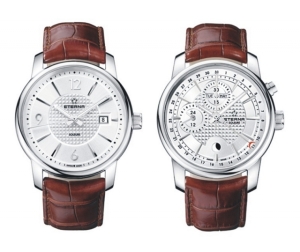
Watch yourself!
Baselworld 2010: a review
Part 1
If we are to believe the chroniclers of the wealthy like Steve Forbes, what affects the world’s haves, will also have an impact on the havenots. It’s a bizarre thought based on some strange algorithm only Forbes might understand – it assumes that X not being able to afford another luxury car is equivalent to Y and his family being expelled from their home. But when it comes to watches, the algorithm might just work. Because luxury is the projection and realization of some personal fairytale, and it touches everyone at all levels. For some, purchasing a muscle car is the lonely cherry atop an otherwise gloomy cake, and for others gazing at a tourbillon and a pumping hairspring may be the only way to remember one’s own beating heart in a life of soporific board meetings and business-class plane travel. You don’t really buy a watch, especially a mechanical one, to tell the time, but rather to have a little bit of the galaxy on

or on the wrist of a loved one. It makes no difference whether it’s a €210,000 Chanel limited edition, or an entry-level Eterna … It’s one of the messages that became quite obvious at Baselworld, the annual watch and jewelry orgy held in Basel, Switzerland.
This great trade fair just closed its doors on a happy note, with attendance up by 7% over last year, according to the fair’s daily herald, and the industry generally upbeat about the future. But optimism among the watch brands is not new. Even in the depths of the recession, CEOs and the brands’ majordomos of communication were grabbing at any number that suggested black and not red, and smiling through the drizzle of bad news. As a last resort, they would point to the overheated market until 2008 and suggest that the ensuing crash was merely a natural correction. Quite true, of course, but since the Lehmann vaporization, the Madoff hanky-panky, even the now forgotten scandal at the Société Générale, the luxury industry has been faced with a dilemma. On the one hand, liquidity problems and continuing insecurity in the markets — see Greece – means that the recovery has the energy of the prisoners staggering into the light at the beginning of act II of Beethoven’s Fidelio. On the other hand, the very raison d’être of luxury, exhibitionism, is now considered to be in even worse taste than it ever was. Money is a little tight for everyone thanks to the pathological greed of the past few years, but for those who have it, broadcasting the fact seems to suggest a “let them eat cake” attitude. And we know where that ended.

Turning back the clocks
So it’s no surprise to hear just about every brand speak of “classic” values mixed in with the usual fusion of traditional crafts with innovative ideas. The era of bling has passed, and serious watch aficionados are not entirely unhappy with that state of affairs. Just as censorship in the former USSR led Russian writers and composers to weave a great deal of dissident subtlety into their creations, so, in the year 1 after the Great Recession, sleek lines are back, thin, elegant watches with plain bar indices are in, so are the comfortable rectangular shapes of the 1950s, 1960s and 1970s. Symmetry, or at least harmony and balance, has returned to the dials, but without the slightest sense of stodginess. And steel casings are suddenly quite fashionable — whereby red and yellow gold are beginning to return.
Many of the older brands seemed to have had a great time rummaging around their archives and digging up older designs that hark back to simpler days. Eterna, for instance, is pushing its delicate Soleure, with Arabic numerals or bar indices, a day and night watch for all occasions. Longines has a re-issue of the Lindbergh chronograph, a manly piece but hardly Hummer-like; Tutima has resumed its 1941 Flieger Chronograph line, also recalling the brave flyers of yore, while its Classic line is a genuine chameleon, with sharper contours suggesting this millennium.

No brand epitomizes more the changes of the past three years than Zenith, perhaps. The flamboyant Thierry Nataf of Moet fame had tried to reinvent the traditional brand to meet the exhibitionist tastes of a class of nouveaux riches that partly crashed along with the rest of the economy all the while burying the company’s very DNA. It was like spray-painting flames on the side of a Steinway concert grand for a Grigory Sokolov recital of Brahms’s late works…. To Nataf’s credit, it might have worked had the world economy simply continued to exist on the hallucinogenic expectations of derivatives. Suffice to say, Mr. Nataf – who once told me in an interview, he was “born in a boardroom” – was kicked sideways and replaced by the stolid Jean-Frédéric Dufour, a Geneva resident with a real horological pedigree that includes stints at Ulysse Nardin and Chopard. Gone are the über-cool male models with their brummagem scholar-cum-samurai appeal and the glam femmes objets. Gone are the aphoristic quotes that may be interesting while waiting for the subway, but signified nothing in terms of watches. Gone, too – but not sideways – are about 25% of the old staff. Zenith has turned the clock back and is producing strong, basic, watches, with the good and friendly looks of high-attitude Jura farmers and affordable prices. The big news is the El Primero Striking 10th, which shows each of the ten beats per second of the exceptional caliber (which beats at 36,000 vph), thanks to the jumping seconds hand. Back to the roots, indeed… All that’s left of the flashy pre-Dufour days, apparently, is the company gift candle sputtering away on the receptionist’s pulpit and producing a penetrating, musky-spicy odor that mixed somewhat irritatingly with the garlic used by Zenith’s own booth cooks.

If it ain’t broke …

Some brands did not need to turn down the volume too much, simply because they never really lost their dignity in the first place. Chronoswiss, Doxa and Tutima, for example, are classics by nature, and like Breitling, Fortis, TAGHeuer, have all maintained their genetic association with big engines, diving, flying, regattas, while offering the occasional bit of craziness. It might be a surprisingly gaudy strap, or a limited edition, like Fortis’s Mattern, which was designed by artist Michael Mattern, a specialist in transcending the inner workings of our industrial age. Another manufacturer worth mentioning here is Eberhardt, whose watches seldom venture beyond the straight and narrow but manage to achieve recognizability without going to extremes: The standard Chrono4 series, with its four small dials, would not raise your granddad’s eyebrows, though the Temerario sub-line, in a tonneau case with the four subdials arranged vertically does generate some additional excitement. And then there is the crown buried like a gas cap behind a metal flap between the two 12-0’clock lugs.

Higher up on the scale is DeWitt, where a class and luxury do a little slumming with the steam-punk crowd. That tiny chain used to connect the power reserve in the Academia line is not just a visual delight, but rather part of an innovative system to ensure that the driving force of the tourbillon is constant. Chopard is another brand that has parked itself in the grand old days of leather helmets and mud-speckled goggles. For the company’s 150th anniversary, it has developed several new timepieces, notably a pocket watch that functions as a wristwatch as well as a tribute to founder Louis-Ulysse Chopard. The movement driving this serene piece was produced by a collaboration between the company and the Geneva Watchmaking School, which needed some components for the apprentices’ master works.

Another brand which has defined itself by sticking to its retro birthright is Cuervo Y Sobrinos. Like Chopard and the Mille Migli, CyS also embraces the world’s great car races, like the Grand Prix, as a sort of public identity. Whereby the dignity of the elongated case of the Esplendidos line suggests more the sensuality of a slow rumba, wafts of sweet and spicy cigar smoke, lazy afternoons, the sexiness of taking time rather than racing through it. The Pirata line offers the same identity, with a little more sportiveness, a whiff of tang coming through the porthole shaped case and the crown and push-buttons recalling blunderbusses and a cannonball, a humorous watch for walking the plank with.

It’s not over yet: Check out Part 2 .

